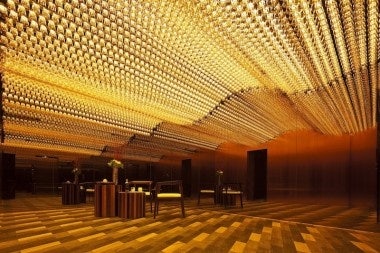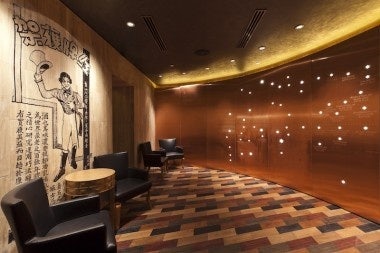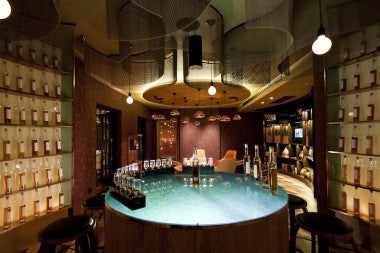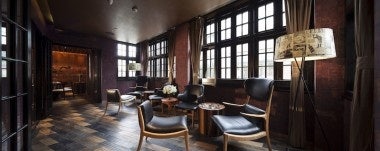Sinan Mansions "House" Includes Private Bars, Interactive Displays, Limited-Edition Bottles#

Image courtesy Johnnie Walker House
Launched this past May at Shanghai's Sinan Mansions, the first Johnnie Walker House built outside of Scotland is nothing if not a shrine to the history, culture and appreciation of whisky. Built to educate local drinkers, many of whom have long been accustomed to watering down whisky with sweetened green tea, or seeing cognac as the only premium imported spirit on the market, the three-story Johnnie Walker House takes visitors on a step-by-step tour through the production and enjoyment of whisky.
Beginning with an introduction to the raw materials of whisky -- barley, water and peat -- upon entering, guests to the Johnnie Walker House are taken through an "experience" that includes a detailed copper scale model of a Scottish distillery and high-tech, interactive sensory table that teaches visitors the fundamental aromatic and tasting notes of Scotch whisky. Finally, after having been filled in on the basics of whisky appreciation, guests are led to the third-floor lounge for a tasting session led by one of the House's resident experts.
For the Johnnie Walker House, owners Diageo have spared no expense. The dimly lit spaces emulate a private residence, albeit one with floors lain with re-purposed oak barrels and chandeliers fashioned from crystal highball glasses. But with whisky still more widely known as a mixer more than a premium spirit in China, and well-heeled Chinese still regularly opting for cognac or rare wines for personal enjoyment or gift-giving, can the Johnnie Walker House change perceptions of whisky and transform whisky culture in China? Jing Daily recently made a trip down to Sinan Mansions to put these questions to Lawrence Law, brand director at Moët Hennessy Diageo, at the Johnnie Walker House.
Jing Daily (JD): As Johnnie Walker entered, or rather re-entered, China quite recently, what's been the biggest obstacle here in terms of competition? What’s your strategy for turning cognac drinkers into Scotch drinkers?#
Lawrence Law (LL)#
: I think from a cognac perspective, cognac has been here for the longest time, far longer than whisky historically. A lot of the imported spirits culture in China is largely driven by the Hong Kongers and Taiwanese who ring along the coastline. So you'll notice in the north, for example, people are often still drinking baijiu rather than whisky. From our point of view, one reason for building the House is to bring Scotch into China and give Chinese a different perspective of it.
If you look at the last 10 years, Scotch has been relatively unknown in China. It's largely consumed by younger drinkers in bars. But what I think the strategy with the House is, aside from giving people the chance to learn about whisky in its purest form outside of Scotland, is it gives us the ability to give Scotch a much more premium image. And not just for Johnnie Walker. I think, obviously, building a place like this is really making a statement, that we are one of the leading whisky houses in the world, and we have a wide range apart from the commonly known Black Label. We have highly limited editions that cost as much as premium cognacs.
So I think that this place is a way to "premium-ize" our brand in China as well as educate consumers about whisky in general.

JD: You're located at Sinan Mansions, surrounded by many higher-end restaurants and shops, which to some visitors could be somewhat intimidating. Is that part of the reason tours are laid out in stages, to make guests more comfortable?#
LL#
: We chose Sinan Mansions because, from a location perspective, we think that this is the next up-and-coming Xintiandi. I think right now Xintiandi is becoming a lot more commonly known as a tourist spot. [Sinan Mansions] is one of the few places that has been recently done up as a historical area, preserving some of the old Shanghai houses. In terms of intimidation, we haven't experienced that. And partly, I think, that's because this is more of a destination than a place for people to just walk in. Over the last two months, we have had maybe 500 or 600 guests here, trade customers as well as friends bringing friends. I think what we've done here is to compartmentalize the experience, from the first floor to the second floor to the third floor. I think this helps them absorb it in the right way, rather than throwing all of the information at them in one go.
JD: The way the stages go, starting with the raw materials of whisky and ending up on the third floor actually drinking the finished product, do you think that's something the local customers appreciate? Is that kind of sense-heavy approach something critical for the premium spirits market in China?#
LL#
: When we built this place, we spoke to many guests and what we found is that when you take them through the stages, if you just let them taste the whisky and that's it, they'll say "Yes." That's very Chinese in nature -- saying, "Yeah, I know." But they don't actually know. So if you look at the process, going through the raw materials and teaching them what a distillery looks like inside and out with a model, taking them to the second floor to open their senses at the scent table, by the time they get to the third floor and taste the whisky, they can actually taste a lot more because their minds have opened up. And I think that's extremely important when we talk about a premium whisky.
Here, we talk about the craftsmanship behind whisky, we talk about the 10 million casks in Scotland that we can take advantage of for blending custom bottles. Visitors get the full spectrum here. So we've been right with our strategy so far, I think, because the way we lead guests through the House teaches them to appreciate the differences between standard and premium Scotch.
JD: What are your observations on the tastes of different people who come here from different places in China? How do tastes broadly differ?#
LL#
: If you look at the dinners we do here, the food that we pair the whiskies with, we tend to use Shanghainese food as the baseline. But there are definitely different perspectives when you go to other areas in the south, like Xiamen or Guangzhou, where people are broadly lovers of seafood. We have educational programs there in restaurants where we teach people how to pair with seafood. Since people still mostly drink cognac in the north, we're exploring how to educate people on pairing with food in the north. We haven't yet looked too much into pairing Scotch with the hot and spicy flavors in places like Chengdu, because cuisine there can be quite strong and a lot of people still like to pair that kind of food with baijiu.
So our focus is still mostly in the south and the more cosmopolitan cities like Beijing and Shanghai. In the south there's a large drinking culture during dinner, and it's a combination of whisky, cognac and baijiu, while in the north it's still mostly baijiu. Right now the low-hanging fruit is in the south, where we can educate people on how to bring whisky into their dining occasions. In the north we have to start somewhere, but our priorities are still positioning ourselves in the current drinking culture rather than trying to change the drinking culture itself.
JD: In terms of generational differences, which are pretty noticeable in most segments of the luxury industry here, are you targeting younger drinkers? Or are you mostly focusing on middle-aged consumers, as Scotch makers often do in the US and UK?#
LL#
: If you look at the segmentation strata in China, it can be quite complex, because you've got [outliers like] the young entrepreneurs and the "second generation rich" kids. I guess to put it into perspective, if you look at the younger generation, they're trying to experiment with imported spirits, and we don't usually take them through the full experience [at the Johnnie Walker House]. We tend to use more fun, energetic marketing for them. For example, we recently did the Yulu campaign, which was energetic and thought-provoking for the younger generation. And it's been the most successful campaign we've ever run in China. It's been seen by something like 20 million people online, and that's going to reposition the brand as a whole.
If you look at the premium side, this location is a lot more for -- we don't talk about age, we talk about affordability -- anybody who can afford Blue Label and above. Essentially, we have two different experiences we're going for in China, one more energetic and another more premium. If you look at cognac, for example, the older generation don't really drink whisky as much because they're still drawn to cognac. So we're trying to educate customers about the craftsmanship and flavors of whisky. You kind of have to have whisky, you can't just have cognac as a pleasure in life.

JD: Do you find now that whisky is becoming a more accepted business drink in China?#
LL#
: It's still in the early stages. If you look at the House itself, we do allow people to buy and consume immediately, and when we have business occasions here and bring people together, they'll easily open a bottle of 1910 and drink it on the spot. But all of this takes a bit of time, we don't expect it to accelerate to [the level of cognac] so quickly. As long as we bear in mind that what we're trying to do here is build a whisky culture, whether it's in leisure and business, people will start to follow. So the answer, I would say, is that it's in the early stages, but we expect to see that start changing.
If you look at the recent [Mid-Autumn Festival] gifting season, we had more orders of limited editions than ever before, because people are giving whisky as a business gift, not just for personal gifts. It's a very important entry point. I think gifting is still one of the key channels to making us more widespread.
JD: In addition to building the house and educating consumers, what, like getting gift boxes right, has been the biggest challenge in terms of getting mobilized for the Shanghai market?#
LL#
: I'm not sure if there have been challenges, more than anything it's been insightful for us. Because many times when we create new experiences or gift packages, it's seen through the lens of a Chinese luxury consumer. And one of the luxuries we've had is that even though we're a global brand, what we're doing is very much for local consumers. And based on what we've found through talking with people here who've come by, I think we can say we've hit upon the right formula. The recent festival sales have been a good proof point that what we've done here in terms of limited editions and packaging has been good. And I think it's quite basic. If make a good drink and have good packaging, it will move here. If we've got the right elements, the right insights, the right price points, business will be good.
JD: What do you think it is about Scotland that is so appealing to luxury consumers here? Golf, cashmere, whisky -- it's almost like Scotland is a counterpoint to France in the Chinese luxury industry. I'd be curious to get your thoughts on that concept.#
LL#
: Well, I think Scotland is a relatively unknown destination, and I think a lot of people here just know Scotland in terms of cashmere and whisky, these are the two main exports we see. And I think that the way we talk about Scotland has changed perceptions of it being more of an industrial place than a destination that has the right landscapes, scenery, and experiences. In fact, we do customized tours to Scotland as a service for some of our more premium customers, because we have a Scottish heritage team that sits on the global team. I think a lot of things we're doing is helping consumers understand what Scotland is all about. If you look at New Zealand, for a long time it has been considered a luxurious destination in China, and I think Scotland will be seen as a premium location in China in coming years as well.
JD: Earlier on the tour, you mentioned that you often encourage local visitors to experiment with drinking whisky with a bit of water to open up the aromas. Do you find that after going through the experience here, that people still like to mix whisky with sweet green tea or other things?#
LL#
: I'm confident that what we're doing is changing the way people are consuming whisky. And I don't think we're changing it for everybody, but I think the people who've gone through the tour are teaching their friends how to appreciate whisky. I know we're making positive changes, at least among the people who come here and regularly come back. They never ask for Scotch mixed with green tea anymore. I've gotten to the point where I'll say, if you want to mix something into your drink, don't even bother with Scotch, try vodka, which is alcohol in its purest form. And on the tour, we explain how visitors can try it in different ways, like on its own, with one cube of ice, two cubes of ice, with water, with soda. The different spectrums of the flavors come out, and every individual will find the one he or she likes the best. I'm confident we're changing the culture. The people we bring here do have influence over their friends and social circles, so it will help.
Also, if you look at the promotions we work on with partners and bars, it's moving away from green tea. If we talk about Gold Label, we know we can't change mixing culture, but we give people tools to mix drinks in correct proportions. Like we have glasses that explain how much Gold Label to add, and how much water and ice. I think this is very fresh news for people interested in whisky, and getting them away from mixing with green tea or other mixers. It really helps us position away from our competitors.
We're not saying you can't do it, we're just saying the best way to drink it is up to you.

JD: How do you feel that whisky consumption at this level fits into the broader China luxury market, in terms of consumer taste and development?#
LL#
: We're doing our part to change the premium image of Scotch as a whole in China, and we're changing our packaging for this market as well, even for our standard Scotch bottles and packaging. If you look at our 1910 limited edition, the bottle is standard but the box is special. We also have changed our Blue Label bottle to make it heavier and weightier, because these are luxury cues we know the Chinese consumers want. If we keep using standard packaging, it's not going to work in China. This helps us reposition our products in the luxury space according to luxury trends in China.
There are definitely luxury cues we look to here. One very interesting point about Chinese consumers is [the product still] has to look European. You look at our packaging and it's very European. They like that for some reason. When we talk about Johnnie Walker in China, especially our luxury labels, we talk about the rarity of the liquids in the bottles, they're over 50-60 years old, and we mention the three C's -- the character of the liquid, the cask, and the craftsmanship behind it. These are cues the Chinese consumers like to hear. Chinese consumers have accelerated very quickly. If you look at just five years ago it was still very bling. Now people are asking, "What's inside?" and it's not just the packaging, it's much more discerning than before.
JD: That's an important shift.#
LL#
: It's a very, very important shift. And I think it's the general trend for luxury brands in China now.